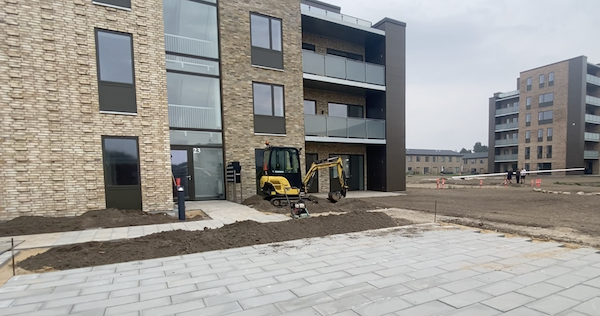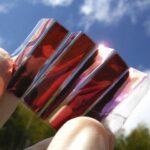Hej, from Denmark!
I’ve long romanticized Danish culture. Denmark has cracked the code to many social problems that seem intractable in the United States, from free health care to free college. It’s figured out how to ritualize the art of being cozy. It’s home to the happiest city on earth. The politics are so ideal, Denmark was a talking point during Bernie Sanders’ 2016 campaign as a role model for the U.S. — an idea that resonated with a generation of young liberals and led to a Bernie-fueled tourist bump in Denmark.
When it comes to climate, Denmark is just as admirable. Denmark is one of the few countries with a legally binding goal to reduce emissions, which it set as 70 percent by 2030 and reach carbon neutrality by 2050. (The United States, by contrast, is aiming for a 50 percent reduction by 2030.)
Denmark is nimble. In 1965, Denmark got practically no energy from renewable sources. Today, 30 percent of its energy is renewable, ranking ninth in the world. This quickly transitioned away from coal in the last two decades, and today gets 30 percent of its energy from renewables. This progress got itself this year’s top performing spot in the Climate Change Performance Index.
As communities and companies across the world are crystalizing decarbonization strategies, what could be emulated from the Danish example?
Sonderborg is Denmark’s Denmark
If the world looks to Denmark for clues on effective policies, Denmark could look to Sonderborg, a municipality in the south of the country, for its own inspiration.
Sonderborg has an aggressive plan of action to decarbonize its entire energy system by 2029, and is 55 percent of the way to meeting that goal.
While net-zero is a common guiding principle today, Sonderborg was one of the first — if not the first — to set its sights on carbon neutrality. It announced the goal in 2007 — eight years before the Paris Accord, and two years before Copenhagen made a similar commitment. (If you know of a city that did this earlier, I want to know about it.)
Leading this effort is ProjectZero, a public-private partnership between the city, local companies and members of the community. (Project Zero, together with Danfoss, a engineering and technology company, footed the bill for this reporting trip.)
Impressively, the ProjectZero area aims to achieve this goal using all-local resources, fitting together specific strategies and engaging local stakeholders to completely decarbonize energy — without importing energy resources or using offsets.
Let’s pause to reflect on how ambitious that challenge is. This is a country with long, dark winters — meaning demands for light and warmth are high. There are months on end with very little sun for solar. And Sonderborg is small, with about 100,000 people in the region, so creating a plan to meet all energy needs requires a careful integration of resources.
Core to its strategy is cross-sectoral projects, integration of resources and buy-in from the community at a city-scale. That collaborative spirit is the secret sauce to a transformational shift, according to ProjectZero.
“The challenge today is to decarbonize cities,” said Brian Seeberg, CEO of ProjectZero. “Things are moving away from components to overall solutions. So we are both demonstrating how to lead and manage and engage people around climate goals in an urban context.”
Their recipe has three steps: Use only energy needed through deep efficiency; reuse energy already produced; source the rest from renewable energy sources.
Step 1: Reduce energy use
Energy efficiency is ProjectZero’s true north. The organization sees efficiency as an impact multiplier, making all other initiatives more effective, powerful and affordable. According to its research, efficiency can reduce the costs of reaching net zero by almost 50 percent.
Sonderborg has demonstrated this potential well in the residential sector. One housing development, Linde Haven, uses advanced efficiency technologies to drive down the energy demands. The 140-unit complex includes smart technologies, such as predictive control systems that can reduce heating consumption by 11 percent, electronic thermostatic radiators to retain specific room temperature and a system that balances hot and cold water in the heating system, which can save 10 percent of final energy with a payback of one year. It’s so efficient, it is able to run on low-temperature district heat, which can reduce distribution heat loss by almost a third, according to estimates.

If done well, efficiency could avert the need for costly new renewable power plants, offering deeper savings to communities making decarbonization more possible and feasible.
“It really makes sense to think energy efficiency first,” explained Seeland. “Energy efficiency is, to some extent, boring to talk about. But you’re wasting a lot of energy today, and green transition is expensive.”
Yet despite these technologies existing with attractive payback periods, the world has struggled to keep pace with energy efficiency targets. According to the International Energy Agency (IEA), to reach net zero emissions by 2050 we’d need 4 percent annual improvements in energy intensity — yet we’ve averaged just 1.3 percent globally over the last five years.
Sonderborg’s strategy to increase efficiency globally: Inspire by example, and invite journalists (hi!) and leaders to see demonstration projects. This plan is why ProjectZero invited the IEA to hold its annual energy efficiency conference in Sonderborg in June, and why IEA’s executive director, Fatih Birol, dubbed the city the “Global Capital of Energy Efficiency” after seeing its efforts.
Step 2: Reuse energy through connecting projects
Key to decarbonizing energy systems is integrating projects and strategies across the region. ProjectZero did this by breaking down challenges and opportunities into 15 focus areas in buildings, transportation, industry and energy, and finding local stakeholders to drive project management.
While ProjectZero’s master plan is specific to Sonderborg’s resources, the process is replicable for other locales. The insight is the power of considering the unique mix of small solutions in a community that, in aggregate, amplify positive outcomes. This requires ongoing and meaningful cooperation across sectors.
“If you start working across silos, you really start getting to the point,” said Lars Tveen, chairman of ProjectZero. “And you can only do that if you’re able to really convert ‘what is in it for me’ down to citizens, down to the different parts of a society.”
An excellent example is Sonderborg District Heating. The network connects homes and businesses across the municipality into a single system, allowing them to share heat resources for air and water heating. The system reaches more than 80 percent of the homes in the region, reducing their energy demands for space and water heating by 73 percent.
Businesses and industries that generate excess heat can capture that and sell it to the district system, both reducing the amount of energy needed for space and water heating for neighbors and creating a new source of revenue.
One business leveraging this scheme is the supermarket SuperBrugsen. The store installed a recovery unit to capture heat waste from its refrigeration system. That is then reused to heat the store and create hot water — reducing SuperBrugsen’s demands for energy to heat by 78 percent. This is a logical evolution of the standard HVAC model, where heat exhaust from refrigeration is released outside, then a different, energy-demanding system works to get the indoor temperature just right.
The cherry on top: When the supermarket creates more heat than it needs, it sells it into the district heat system to benefit neighboring buildings — while making a little money.
Step 3: Replace energy resources with clean energy
Once energy is reduced and repurposed, the last step is to transition what’s left to clean energy. If the first steps are done correctly, this will be a much smaller lift.
The region already has wind, solar, a biogas facility that uses waste from local farms, a trash incinerator used for heat (which is not considered renewable in Denmark), and a carbon-negative, energy-generating water treatment plant.
Two of these resources — biogas and the trash incinerator — I found particularly intriguing. Both are controversial in the climate community in the United States, and I found Sonderborg’s approach to both refreshing.
Sonderborg see biogas as a valuable tool to transition from natural gas — which it values both for its climate benefit and its desire to break dependency on Russia, which provides most of Denmark’s gas. So far it’s working: during a particularly warm day recently, biogas made upwards of 98 percent of the gas in the infrastructure — an incredible feat.
In the US, biogas (dubbed renewable natural gas by the natural gas industry) is locked in a battle where gas companies aim to use it to slow efforts to electrify, and climate advocates are wholly suspicious of it in response. This dynamic means biogas isn’t being used where it could be valuable, and the general public is confused. Denmark’s clarity here is refreshing.

The garbage incinerator was a sight to behold. In the U.S., this is controversial, as dirty facilities are linked to environmental racism and pollution. The facility in Sonderborg is designed to capture the heat for the district heating system, and a series of flumes capture pollution and toxins to sequester emissions and functionally eliminate impacts to air quality, according to leadership at the facility.
Sonderborg’s next step: continue to build out its solar and wind capacity (including an offshore wind farm scheduled to go online in 2027) and create a green hydrogen facility to use excess generation from wind resources. That hydrogen could be used as energy storage or with methane from the biogas plant to create a variety of fuels for sectors where electrification isn’t possible, such as shipping, aviation and plastics.


A note from the author
I would be remiss to not mention Danfoss, a engineering company that makes components for a variety of technologies such as HVAC systems and hydraulics. Danfoss is headquartered in Sonderborg and its family foundation is one of the funders of ProjectZero, as well as a sponsor of my trip to Denmark.
Danfoss has a dog in this fight. Part of its motivation to promote energy efficiency is because it manufactures many components in leading energy efficiency technologies. The company openly recognizes that energy efficiency will help its bottom line, as well as its desire for other localities to follow the example it has set in Sonderborg to grow its business.
After spending four days with people from ProjectZero and Danfoss, this double incentive does not give me pause. I agree with Danfoss that there is a wealth of opportunity in climate solutions, and I don’t think Danfoss’ desire to grow its efficiency business is at odds with climate efforts.
Credit: Source link



